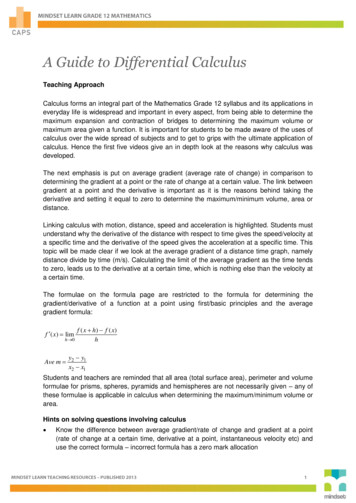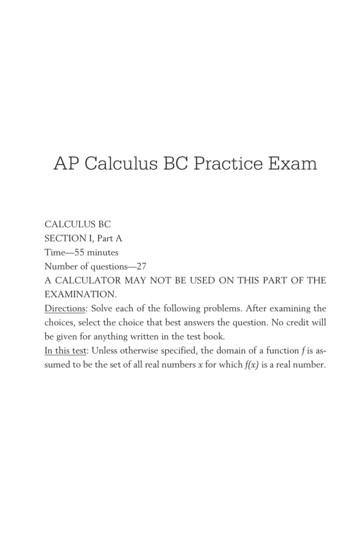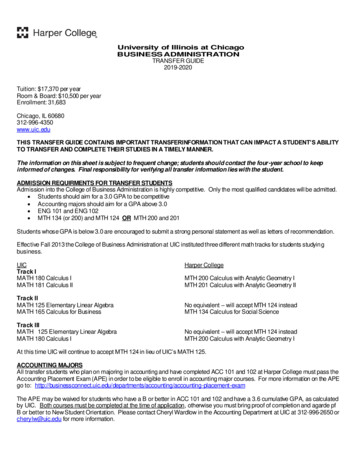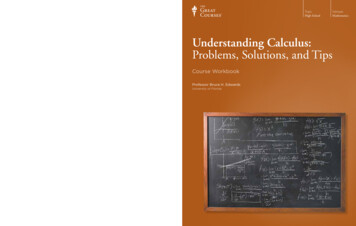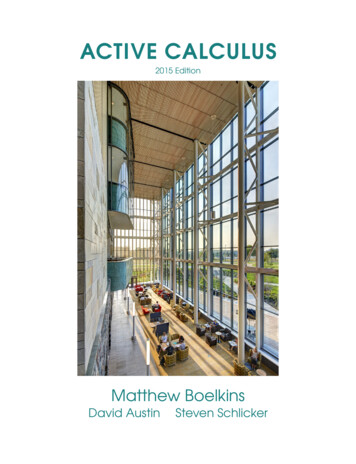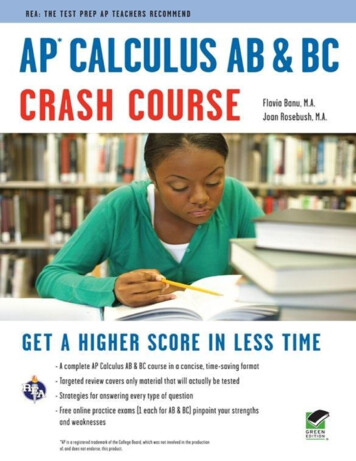
Transcription
Planet Friendly Publishing Made in the United States Printed on Recycled Paper Text: 10% Cover: 10%Learn more: www.greenedition.orgAt REA we’re committed to producing books in an earth-friendly manner and to helping our customersmake greener choices.Manufacturing books in the United States ensures compliance with strict environmental laws andeliminates the need for international freight shipping, a major contributor to global air pollution.And printing on recycled paper helps minimize our consumption of trees, water and fossil fuels. Thisbook was printed on paper made with 10% post-consumer waste. According to EnvironmentalDefense’s Paper Calculator, by using this innovative paper instead of conventional papers, we achievedthe following environmental benefits:Trees Saved: 5 Air Emissions Eliminated: 1,104 poundsWater Saved: 1,082 gallons Solid Waste Eliminated: 326 poundsFor more information on our environmental practices, please visit us online at www.rea.com/greenResearch & Education Association61 Ethel Road WestPiscataway, New Jersey 08854E-mail: info@rea.comAP CALCULUS AB & BC CRASH COURSECopyright 2011 by Research & Education Association, Inc.All rights reserved. No part of this book may be reproduced in any form without permission of thepublisher.Printed in the United States of America
Library of Congress Control Number: 20109380279780738666280REA is a registered trademark ofResearch & Education Association, Inc.A11
AP CALCULUS AB & BC CRASH COURSEAccess Your Exam
Table of ContentsTitle PageCopyright PageAP CALCULUS AB & BC CRASH COURSEABOUT THIS BOOKABOUT OUR AUTHORSACKNOWLEDGMENTSPART I - INTRODUCTIONChapter 1 - Keys for Success on the AP Calculus AB & BC ExamsPART II - FUNCTIONS, GRAPHS, AND LIMITSChapter 2 - Analysis of GraphsChapter 3 - Limits of FunctionsChapter 4 - Asymptotes and Unbounded BehaviorChapter 5 - Continuity as a Property of FunctionsChapter 6 - Parametric, Polar, and Vector EquationsPART III - DERIVATIVESChapter 7 - DerivativesChapter 8 - Curve SketchingChapter 9 - Optimization and Related RatesChapter 10 - The Mean Value Theorem and Rolle’s TheoremChapter 11 - Newton’s Method and Euler’s MethodPART IV - INTEGRALSChapter 12 - Types of Integrals, Interpretations and Properties of Definite Integrals, TheoremsChapter 13 - Riemann Sums (LRAM, RRAM, MRAM) and the Trapezoid RuleChapter 14 - Applications of AntidifferentiationChapter 15 - Techniques of IntegrationPART V - SEQUENCES AND SERIES—Chapter 16 - Sequences and SeriesChapter 17 - Taylor and Maclaurin SeriesPART VI - THE EXAMChapter 18 - The Graphing CalculatorChapter 19 - The Multiple-Choice QuestionsChapter 20 - The Free-Response QuestionsSOLUTIONS FOR PRACTICE PROBLEMSWelcome to REA’s Crash Course for AP Calculus AB & BC
ABOUT THIS BOOKREA’s AP Calculus AB & BC Crash Course is a targeted test prep designed to assist you in yourpreparation for either version of the AP Calculus exam. This book was developed based on an in-depthanalysis of both the AP Calculus Course Description outline as well as actual AP test questions.Written by an AP teacher and a college professor, our easy-to-read format gives students a crash coursein Calculus, for both the AB and BC versions of the test. The targeted review chapters prepare studentsfor the exam by focusing on the important topics tested on these exams.Unlike other test preps, our AP Calculus AB & BC Crash Course gives you a review specificallyfocused on what you really need to study in order to ace the exam. The review chapters offer you aconcise way to learn all the important facts, terms, and concepts before the exam. Topics that areexclusive to the BC version of the test are highlighted.The introduction discusses the keys for success and shows you strategies to help you build your overallpoint score. Parts Two, Three, Four, and Five are made up of our review chapters. Here you will find thecore of what you need to know on the actual exam. Read through the material and pay attention to thediagrams. If there’s anything you don’t understand, reread the material, then go back to your textbook, orask your Calculus teacher for clarification. Make sure you’re prepared on test day.Part Six focuses on the format of the actual AP Calculus tests. This includes information about themultiple-choice questions as well as the Free-Response questions. Our authors show you what you needto know in order to anticipate the types of questions that will appear on the exams.No matter how or when you prepare for the AP Calculus AB or BC exams, REA’s Crash Course willshow you how to study efficiently and strategically, so you can get a high score.To check your test readiness for the AP Calculus AB and BC exams, either before or after studying thisCrash Course, take our FREE online practice exams (1 each for AB & BC). To access your freepractice exam, visit www.rea.com/studycenter and follow the on-screen instructions. This true-to-formattest features automatic scoring, detailed explanations of all answers, and will help you identify yourstrengths and weaknesses so you’ll be ready on exam day!
Good luck on your AP Calculus exams!
ABOUT OUR AUTHORSFlavia Banu graduated from Queens College of the City University of New York with a B.A. in PureMathematics in 1994, and an M.A. in Pure Mathematics in 1997. From 1994 to 2008, Ms. Banu was anadjunct professor at Queens College where she taught Algebra and Calculus II. Currently, she teachesmathematics at Bayside High School in Bayside, New York, and coaches the math team for the school.Her favorite course to teach is AP Calculus because it requires “the most discipline, rigor and creativity.”Joan Marie Rosebush is currently teaching calculus courses at the University of Vermont. She alsoserves as the university’s Director of Student Success for the College of Engineering and MathematicalSciences. Ms. Rosebush has taught mathematics to elementary, middle school, high school, and collegestudents. She taught AP Calculus via satellite television to high school students scattered throughoutVermont. Recently, she has been teaching live/online.Ms. Rosebush earned her Bachelor of Arts degree in elementary education, with a concentration inmathematics, at the University of New York in Cortland, N.Y. She received her Master’s Degree ineducation from Saint Michael’s College, Colchester, Vermont. She went on to earn a Certificate ofAdvanced Graduate Study in Administration at Saint Michael’s College.
ACKNOWLEDGMENTSIn addition to our authors, we would like to thank Larry B. Kling, Vice President, Editorial, for hisoverall guidance, which brought this publication to completion; Pam Weston, Publisher, for managing thepublication to completion; Diane Goldschmidt, Senior Editor, for project management; Alice Leonard,Senior Editor, for preflight editorial review; Weymouth Design, for designing our cover; and FredGrayson of American BookWorks Corporation for overseeing manuscript development and typesetting.We also extend our thanks to Joan van Glabek, Ph.D., Edison State College, Naples, Florida, fortechnically editing and reviewing this manuscript.
PART IINTRODUCTION
Chapter 1Keys for Success on the AP Calculus AB & BCExam sLet’s face it. The AP Calculus exams are not easy. The course itself is filled with hundreds of formulas,diagrams, and nuances that can be confusing, and by the time you take the actual AP exam, you may beoverwhelmed by what you “think” you need to know to get a good score. But don’t worry, this CrashCourse focuses on the key information you really need to know for both calculus exams. However, this isnot a traditional review book. During the course of the school year, you should have learned most of thematerial that will appear on the AP Calculus exam you’re taking. If, as you go through this book, youdiscover that there is something you don’t understand, consult your textbook or ask your teacher forclarification.This Crash Course will help you become more pragmatic in your approach to studying for the APCalculus exam. It’s like taking notes on 3 x 5 cards, except we’ve already done it for you in a streamlinedoutline format.
STRUCTURE OF THE EXAMBoth the AP Calculus AB and BC exams have the same format.Numbe r o f Q ue s t io ns /Pro ble msTime( minut e s )Section I28551750230460Part A: No calculatorPart B: Graphing calculator allowedSection IIPart A: Graphing calculator allowedPart B: No calculatorTOTAL TIME195Each section of the test is worth 50% of your grade. You will have 3¼ hours to complete the exams.According to the College Board, in Section II of Calculus AB and BC, if you complete Part A before yourtime is up, you cannot move on to Part B. So if you finish that section early, you will have time to checkyour answers. However, if you complete Part B before your 60 minutes are up, you can keep the greeninsert and return to Part A, without the use of the calculator. The two Part A problems will appear on thegreen insert. Part B questions will appear on a separate sealed insert. You will have enough space towork out your problems in the exam booklet.The multiple-choice answers are scored electronically, and you are not penalized for incorrectanswers. Therefore, it makes sense to guess on a question if you don’t know the answer.In the free-response section of the exams, it is important to show your work so the AP readers canevaluate your method of achieving your answers. You will receive partial credit as long as your methods,reasoning, and conclusions are presented in a clear way. You should use complete sentences whenanswering the questions in this portion of the exam.
For those questions requiring the use of a graphing calculator, the scorers will want to see yourmathematical setup that led to the solution provided by the calculator. You should demonstrate theequation being solved, derivatives being evaluated, and so on. Your answers should be in standardmathematical notation.If a calculation is given as a decimal approximation, it should be correct to three places following thedecimal point, unless you are asked for something different in the question.
THE SCORESThe scores from Part I and II are combined to create a composite score.
AP SCORE SCALE5Extremely well qualified4Well qualified3Qualified2Possibly qualified1No recommendationTo be qualified is to receive college credit or advanced placement. However, the acceptance of thesescores for credit is at the discretion of the individual college.According to the statistics reported by the College Board, 55.6% of all the students who took the APCalculus AB exam in May 2010 scored a 3 or higher and 21.2% received a 5. Almost 50% scored a 5 onthe AP Calculus BC exam.
2010 AP Calculus AB Grade DistributionsCa lc ulus ABEx a mina t io nG ra deNumbe r o f Te s t Ta ke rsAc hie v ing Sc o rePe rc e nt o f Te s t Ta ke rsRe c e iv ing Sc o 33533.1Number ofStudents245,8673 or Higher / %136,942Mean Grade2.81StandardDeviation1.5555.7Source: College BoardIf you’re taking the AP Calculus BC exam, you will receive a Calculus AB subscore for that part of theCalculus BC exam that covers AB topics.
2010 AP Calculus B C Grade DistributionsCalculus BCCa lc ulus BCEx a mina t io nG ra deNumbe r o f Te s t Ta ke rsAc hie v ing Sc o rePe rc e nt o f Te s t Ta ke rsRe c e iv ing Sc o ,03111.4%Number ofStudents78,9983 or Higher / %65,394Mean Grade3.86StandardDeviation1.3882.8%Source: College BoardCalculus AB SubscoreCa lc ulus AB Subs c o reEx a mina t io nG ra deNumbe r o f Te s t Ta ke rsAc hie v ing Sc o rePe rc e nt o f Te s t Ta ke rsRe c e iv ing Sc o re540,27651.0%415,30819.4%311,19314.2%
24,5315.7%17,6909.7%Number ofStudents78,9983 or Higher / %66,777Mean Grade3.96StandardDeviation1.3384.5%Source: College BoardWhat does this all mean? Why is the percentage of people who take the Calculus BC exam so muchhigher than those who take the Calculus AB exam? It has to do with the level of the student taking the BCexam. It doesn’t mean they’re smarter, but rather that they’ve already been through the AB level, whichrepresents about 40% of the BC-level exam, so that part should then be much easier. After all, almost85% who took the BC exam scored a 3 or higher on the AB portion of the BC test.Most of this shouldn’t have too much impact on how you do on the exam. If you study for the test usingthis Crash Course book and pay attention during the school year, you will likely be pleasantly surprisedwhen you receive your scores.
STRATEGIES F OR SCORING HIGHKeep in mind that one of the best ways to prepare for this exam is to research past exams. These exams donot change that much from year to year, so it makes sense to go back into previous tests and answer thequestions. The single most important aspect of scoring high on any standardized test is to have completefamiliarity with the questions that will be asked on the test. You may not find exact questions, but you willfind those that are similar in content to questions you will find on your exam. On the College Boardwebsite you will find past free-response questions posted. The more questions you answer in preparationfor the test, the better you will do on the actual exam.On the actual exam, make sure you write clearly. This sounds like a very simple thing, but if those whoare scoring your exam cannot read your answer, you will lose credit. We suggest that you cross out workrather than erase it.Along those lines, keep in mind that because you will be graded on your method of calculations, makesure you show all of your work. Clearly identify functions, graphs, tables, or any other items that you’veincluded in order to reach your conclusions.Read the graphs carefully, as well as the questions. Make sure they correspond and that you are dealingwith like terms.You do not need to simplify numeric or algebraic answers. Decimal approximations should be correctto three places—unless stated otherwise.
USING SUP P LEMENTAL INF ORMATIONThis test prep contains everything you need to know in order to score well on either the AP Calculus ABor AP Calculus BC exams. The AP Calculus Course Description Booklet published by the College Boardcan also be a very useful tool in your studies. If you go to the College Board website(http://www.collegeboard.org) you can download sample multiple-choice questions, as well as freeresponse questions going back to 2002. Studies have shown that along with understanding the basic ideaof what will be covered on the test (i.e., this Crash Course book), the more practice questions youanswer, the better you will do on the actual exam.Additionally, if you would like to assess your test-readiness for the AP Calculus exams after studyingthis Crash Course, you can access a complimentary full-length AP Calculus AB or BC practice exam atwww.rea.com/studycenter. These true-to-format tests include detailed explanations of answers and willhelp you identify your strengths and weaknesses before taking the actual exam.
PART IIFUNCTIONS, GRAPHS, AND LIMITS
Chapter 2Analysis of Graphs
I. ANALYSIS OF GRAP HSa. Basic Functions—you need to know how to graph the following functions and any of theirtransformations by hand.1. Polynomials, absolute value, square root functions2. Trigonometric functions
3. Inverse trigonometric functions and their domain and range
4. Exponential and Natural Logarithmic functions
5. Rational functions6. Piecewise functions
7. Circle Equationsi. Upper semicircle with radius a and center at the origin:For example,. This is a function.
ii. Lower semicircle with radius a and center at the origin:. This is a function.For example,iii. Circle with radius a and center at the origin: x2 y2 a2. This is not a function sincesome x-values correspond to more than one y-value. For example, x2 y2 9iv. Circle with radius a and center at (b, c): (x – b)2 (y – c)2 a2. This is not a functioneither. For example, (x – 2)2 (y 3)2 98. Summary of Basic Transformations of Functionsa. Making changes to the equation of y f(x) will result in changes in its graph. The following
transformations occur most often.
b. For trigonometric functions, f(x) a sin(bx c) d or f(x) a cos(bx c) d, a is theamplitude (half the height of the function), b is the frequency (the number of times that afull cycle occurs in a domain interval of 2π units,vertical shift.is the horizontal shift and d is the! Keep in Mind. The reciprocal of sin(x),, is equivalent to csc(x), whereas sin – 1(x) is theinverse of sin(x), which is the reflection of sin(x) in the line y x. When changing a function by adding a positive constant to x, the graph will shift to the left, not theright. The graph shifts to the right a units when a is subtracted from x. When graphing a function on the calculator (TI-83 or TI-84), make sure that all the plots are turned
off; otherwise you risk getting an error and not being able to graph. To turn off the plots, press Y and place the cursor on the plot you want to deactivate (whichever is highlighted). Press Enter. An even-degree polynomial with a positive leading coefficient has y-values which approach infinityas x (both ends go up). If the polynomial has a negative leading coefficient, its y-valuesapproach negative infinity as x (both ends go down). An odd-degree polynomial with a positive leading coefficient has y-values that approach infinity asx and y-values that approach negative infinity as x – (the right end goes up and the left endgoes down). If the polynomial has a negative leading coefficient its y-values approach negativeinfinity as x ; as x – its y-values approaches positive infinity (the right end goes down andthe left end goes up).CHAPTER 2PRACTICE PROBLEMS(See solutions on page 193)For each of the functions in problems 1 – 8, draw the mother function and the given function on the sameset of axes.1.2. y 2 3x 4 3.4.5. y ex 2 – 16. y ln(4 – x)
Chapter 3Lim its of Functions
I. MEANING OF LIMITa. The limit of a function, y f(x), as x approaches a number or , represents the value that yapproaches.b. The left hand limit,The right hand limit,L., states that as x approaches a, from the left of a, f(x) approaches L., states that as x approaches a, from the right of a, f(x) approachesc. The expressionstates that as x approaches a, simultaneously from the left and right of a,f(x) approaches L.d. The limit of a function at a point exists if and only if the left- and right-hand limits exist and areequal.Symbolically, ifandthen. The converse is also true.e. If the left- and right-hand limits are not equal at a given x value then the limit at the given x valuedoes not exist.Symbolically, ifthendoes not exist. The converse is also true.
II. EVALUATING LIMITS ALGEB RAICALLYa. Generally,. That is, to evaluate the limit of a function algebraically, substitute x withthe value x approaches. (If x or x – , substitute x with values that are very large or verysmall, respectively.)1. If, b 0, then take the left- and right-hand limits separately to see if they’re equalor not. (In this case, x a is a vertical asymptote of y f(x).) For instance,substituting 0 for x. Since the left-hand limit,unequal,and the right-hand limit,does not exist. Similarly,and the right-hand limit,2. Indeterminate forms:, so. However, the left-hand limit,.afterare
III. EVALUATING LIMITS GRAP HICALLYa. Common limit concepts.1.because the left-hand limit is – and the right-hand limit is .2.lim f(x) because the left- and right-hand limits are both .3.and f(1) 1. The function value and the limit at x 1 are equal.
4.and f(1) dne. The function is undefined at x 1 but the limit exists there.5.and f(1) 2. The function value is not equal to the limit at x 1.
IV. LIMITS INVOLVING TRIGONOMETRIC F UNCTIONSa.andare the most common trigonometric limits; also:1.2.3.4.5.6.7.8.9.10.All the above limits can be found using L’Hôpital’s rule as well. However, knowing theanswer without doing the work will save you valuable time!
V. 1 LIMITS INVOLVING e.a. Basic definitions of e:or1. The above definitions can be used to evaluate the following common limits (with minimalalgebraic manipulation):i.ii.iii.iv.v.vi.These limits can all be evaluated using natural logs but the definitions of e, along withthe algebraic manipulations, save you a lot of time when you consider that you haveless than 2 minutes for each multiple-choice question.! Keep in Mind. The answer to a limit question can only be one of the following: a number, – , , or “does notexist.” Try to imagine the graph of a function when taking the function’s limit.
The limit of a function as x approaches a may or may not be the same as the value of the function at x a. If a function’s limit exists, it must equal a number. A function’s limit does not exist in two cases:when the limit from the left and right of the x-value are unequal, or when the y-values approach . Beware the indeterminate forms!CHAPTER 3PRACTICE PROBLEMS(See solutions on page 195)1.a. 0b. c. – d.e. None of the above2.a.b.c.d.e.0 – 1Does not exista.b.c.d.e.1-10– 3.4.a. 1b. – 1c.d. – e. 5.a.b.c.d.1–1 –
e. Does not exist
Chapter 4Asym ptotes and Unbounded Behavior
I. ASYMP TOTESa. Asymptotes are vertical or horizontal lines (the AP Calculus exams do not include obliqueasymptotes) which a graph approaches. Polynomials do not have asymptotes. The functions that mostcommonly have asymptotes are rational functions,as well as other functions such as y ex,y ln(x), y tan(x), y cot(x), y sec(x), y csc(x), and their transformations.1. Vertical Asymptotes are vertical lines that a graph only approaches but never intersects. (Well,almost never! See a rare example of an exception below.)i. x k is a vertical asymptote of y f(x) if and only if lim f(x) , orboth., orii. For a rational function, the equation of a vertical asymptote is x k if and only ifg(k) 0 and f(k) 0; if, however, f(a) g(a) 0, then, in most cases, there is aremovable discontinuity (a hole, not a vertical asymptote) at x a. An example of anexception to the rule iswhich has an irremovable (nonremovable) discontinuity at x 0 but no vertical asymptote. Also, the functionhas one hole (at x 1, whereboth numerator and denominator are 0) and one vertical asymptote (at x – 1, where onlythe denominator is 0). See graphs below:iii. A function can have an infinite number of vertical asymptotes (for example, y tan(x))Rare example of a graph intersecting its vertical asymptote:
The vertical asymptote for f(x) is x 0 and f(0) 2, thus the point (0,2) is on the verticalasymptote.2. Horizontal asymptotes are horizontal lines that a graph approaches and may intersect.i. y k is a horizontal asymptote for y f(x) if and only if, or, orboth. Horizontal asymptotes give us an idea of the function’s end behavior (as x ).The graph ofand, below, has only one horizontal asymptote, y 0, since. Note that the graph intersects its asymptote at (0,0).ii. A function can have at most two horizontal asymptotes. The function y tan – 1(x), below,has two horizontal asymptotes,sinceand.
iii. A function which only has one horizontal asymptote does not have to approach thisasymptote on both ends! The function 0 sinceand, below, has only one horizontal asymptote, yand so it only approaches this asymptote as x .
II. UNB OUNDED B EHAVIORa. If a function, y f(x), approaches positive infinity either as x a or as x , the function is saidto increase without bound. Similarly, if a function, y f(x), approaches negative infinity either as x a or as x , the function is said to decrease without bound.! Keep in Mind. Remember that a graph might cross both its horizontal, as well as its vertical, asymptotes! Do not confuse vertical/horizontal asymptotes with vertical/ horizontal tangent lines. When finding a vertical asymptote, find the root of the denominator and then make sure that it is notalso a root of the numerator. To be safe, simplify a rational function completely before finding itsvertical asymptotes. Not only rational functions have asymptotes. Functions such as y ln(x), y ex, y tan(x) and theirtransformations have asymptotes as well.CHAPTER 4PRACTICE PROBLEMS(See solutions on page 196)Find the horizontal and vertical asymptotes of the following functions:1.2.3. What conclusion can you draw about the asymptotes of f(x) if:a.b.c.
Chapter 5Continuity as a Property of Functions
I. CONTINUITY OF F UNCTIONSa. A function is either continuous (no breaks whatsoever) or discontinuous at certain points.1. A function y f(x) is continuous at a point, x a, if and only if.Simply put, this states that for y f(x) to be continuous at x a, the limits of the function fromthe left and right of a must be equal to each other and also equal to the value of the function at x a.2. All polynomials are continuous.3. Some of the most common discontinuous functions come in the form of rational functions,piecewise functions and y tan(x), y cot(x), y sec(x), y csc(x) and their transformations.4. A removable discontinuity occurs when an otherwise continuous graph has a point (or more)missing. That is, y f(x) has a removable discontinuity at x a if and only ifbut f(a) L or f(a) does not exist.i. The functionhas a removable discontinuity at x 1 sinceand f(1) 1. In this case, f(1) 2.ii. The functionhas a removable discontinuity at x 0 sincebut f(0) 1. In this case, f(0) does not exist.
iii. A removable discontinuity is one that can be “filled in” (or removed) if the function isappropriately redefined. To remove the discontinuity of the function in part i, the functioncan be redefined as f(x) x. To remove the discontinuity in part ii. The function can beredefined as5. A nonremovable discontinuity occurs at step breaks in the graph or at vertical asymptotes. Thatis, y f(x) has a nonremovable discontinuity at x a if and only ifor both of these limits is .or if onei. The functionhas a nonremovable discontinuity at x 0 (also a vertical asymptotethere) because the function cannot be redefined so that it will be continuous there. This isalso called an infinite discontinuity.ii. The functionhas a nonremovable discontinuity at x 0 (a step break, not a verticalasymptote) because we cannot redefine it so that it will become continuous there. This isalso called a jump discontinuity.6. If a function is continuous it does not have to be differentiable! (A function is continuous at acusp or corner, yet it is not differentiable there; more on differentiability later.)7. Intermediate Value Theorem: If f is continuous on [a, b] and c is a number satisfying f(a) c
f(b), then there is at least one number x in [a, b], such that f(x) c. Simply put, this states that ifa function, f(x) is continuous, then every y-value must have at least one x-value correspondingto it.This result is often used to guarantee the existence of roots of functions on certain intervalssince it leads to the following useful result: If f(a) and f(b) have opposite signs and f iscontinuous on [a, b], there must be at least one solution to f(x) 0 on (a, b).! Keep in Mind. Loosely speaking, a continuous function is one which can be drawn without lifting the pencil off thepaper. Continuity does not imply differentiability. Differentiability does imply continuity.CHAPTER 5PRACTICE PROBLEMS(See solutions on page 197)1. Find the x-values for which2. Find the discontinuities of3. Find all x-values for whichis continuous.and categorize them as removable or nonremovable.is discontinuous.
Chapter 6Param etric, Polar, and Vector Equations2
I. PARAMETRIC AND VECTOR EQUATIONSa. Parametric and vector equations are used to describe the motion of a body. They have differentnotations but describe the same concept. An additional variable is involved, called the parameter,usually denoted by t (for time). The parameter does not appear on the graph, it only represents thetime at which a given particle is at a given point. Both parametric and vector equations arerepresented on the Cartesian coordinate system.1. Parametric equations create only one graph though they contain two equations. They are denotedby:2. A vector equation is denoted by: 〈x(t), y(t)〉 〈(f(t), g(t)〉 or, r(t) (f(t))i (g(t))j.3. A parametric equation can be written in Cartesian form (x – y form) by using algebraicmanipulation.i. For example, parametric equations:, can be written in vector form as 〈x(t),22y(t)〉 〈t, t 〉 or r(t) (t)i (t )j and in Cartesian form as y x2. See graph at right.ii. The difference between a parametric/vector curve and a Cartesian curve is that aparametric/vector curve has direction. When drawing a parametric/vector curve, in part3i, the direction must be specified with arrows, on the graph, in the direction of increasingparameter, or else, the graph will be considered incomplete.
II. P OLAR EQUATIONSa. A polar equation, r f(θ), is written using polar coordinates (r, θ), where r represents the point’sdistance from the origin, and θ represents the measurement of the angle between the positive x-axisand the line segment between the point and the origin. Angle θ is measured counterclockwise fromthe positive x-axis.b. To switch from Cartesian form to polar form use: r2 x2 y2 and; to switch from polarform to Cartesian form, use x r cos(θ) and y r sin(θ).i. To change x2 y2 9 from Cartesian form to polar form, rewrite x2 y2 9 as r2 9 r 3(or r – 3)ii. To change r 4 sec(θ) from polar form to Cartesian form, rewrite r 4 sec(θ) as r cos(θ) 4 x 4.c. Most common polar equations that you must know how to graph
REA’s AP Calculus AB & BC Crash Course is a targeted test prep designed to assist you in your preparation for either version of the AP Calculus exam. This book was developed based on an in-depth analysis of both the

